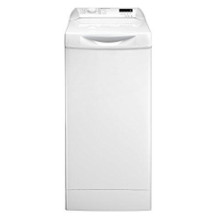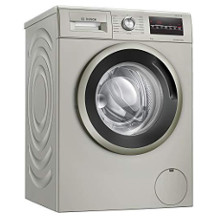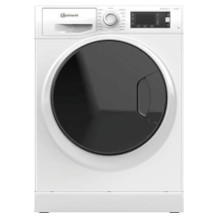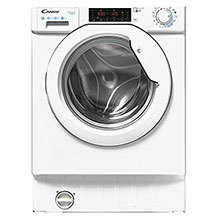Rotary washing line purchasing advice: how to choose the right product
- What you need to know
- Rotary clothes dryers offer space for several loads of laundry on a few square metres and a line up to 60 metres long.
- The frame is firmly anchored in the ground with a sleeve set in concrete or a dowel twisted into the ground.
- Models with a stand can be moved freely, but are less stable than rotary clothes dryers fixed to the ground.
- The “Easy-Lift-System” allows the height of the rotary dryer to be adjusted to prevent backache.
- On a model with a line retraction system, the clothes line disappears into the support arms as soon as you fold it up.
I think I’m crazy!
Conventional clothes racks usually offer little space to hang your laundry smoothly and let it dry. They are also unstable and easily tip over in the wind. Clothes dryers also have their shortcomings: they consume electricity, which costs money, and are not particularly environmentally friendly. For those who have the space available and are looking for a sensible outdoor alternative to drying laundry, a rotary clothes dryer is recommended. It allows you to dry several washing machine loads in a small space and even hang up large items of laundry without wrinkles. To prevent the rotary dryer from giving way to the wind, it is anchored to the ground with a dowel or set in a sleeve set in concrete.
How is a rotary dryer constructed?
A rotary dryer consists of a tube from which four support arms extend. A clothesline is stretched in several rows between these arms. You can hang the laundry on it with or without clothes pegs. The support arms are often equipped with holders for hangers. The rotary clothes dryer got its name from the arrangement of the line, which looks like a spider’s web when viewed from above.
This is how the first of its kind developed
The first idea of a stationary rotating clothesline can be found in an English patent specification from 1923, which is attributed to the two engineers Frederick Fairbourn and William Stevenson. From 1947 onwards, the model reached the masses when the Swiss entrepreneur Walter Steiner began selling wooden “clotheslines” with hemp lines based on the English model. His company bore the name Stewi, which is a combination of his surname and place of residence (Winterthur). To this day, the object commonly known as a rotary clothes dryer in this country is called Stewi in Switzerland.
How does a rotary dryer work?
A rotary clothes dryer has a folding mechanism that works in a similar way to a parasol: When folded, the support arms are against the central tube. Slide the ring upwards to open the “line net”. Folding is just as simple: as soon as you pull the ring down, the support arms nestle against the tube. Depending on the model, the line then hangs loosely down or disappears well protected in the support arms.
What are the advantages of a rotary dryer?
The majority of rotary dryer models are designed for outdoor use in the garden, on the terrace or balcony. If you dry your laundry outside, it will be fresher, you won’t use electricity with the tumble dryer and you won’t involuntarily increase the humidity in your home. In addition, a rotary clothes dryer is more stable than any conventional clothes horse and keeps your laundry firmly in place even in strong gusts of wind. You can hang long items of laundry without any problems: Unlike conventional clothes racks, they do not touch the floor, which would make them dirty again immediately. The long clothesline of the spider offers space for up to seven washing machine loads in a small space and can be used more effectively than a clothes horse. When folded, the rotary clothes dryer is extremely space-saving. Since the line is at eye level, you do not have to bend down when hanging up and hanging out the laundry. This is easy on your back.
Advantages
- Long clothesline
- Plenty of space for large items of laundry
- Extremely stable
- Easy to hang up and take down
- Particularly space-saving when folded
- Easy drying in the fresh air
- Environmentally friendly
Disadvantages
- Requires a lot of space when open
- Dependent on weather conditions
- Installation site often final
What types of mounting are there for rotary dryers?
The most common rotary dryer models are attached to the ground with a corresponding bracket. For this, you either use a dowel that you drill into the ground or a sleeve that you embed in concrete. In both cases, you then insert the rotary clothes dryer pipe into the bracket. Depending on the conditions of the location, it may be more advisable to use models that are free-standing on a stand or that can be attached to the wall. Both variants also have the typical line net for hanging up the laundry.
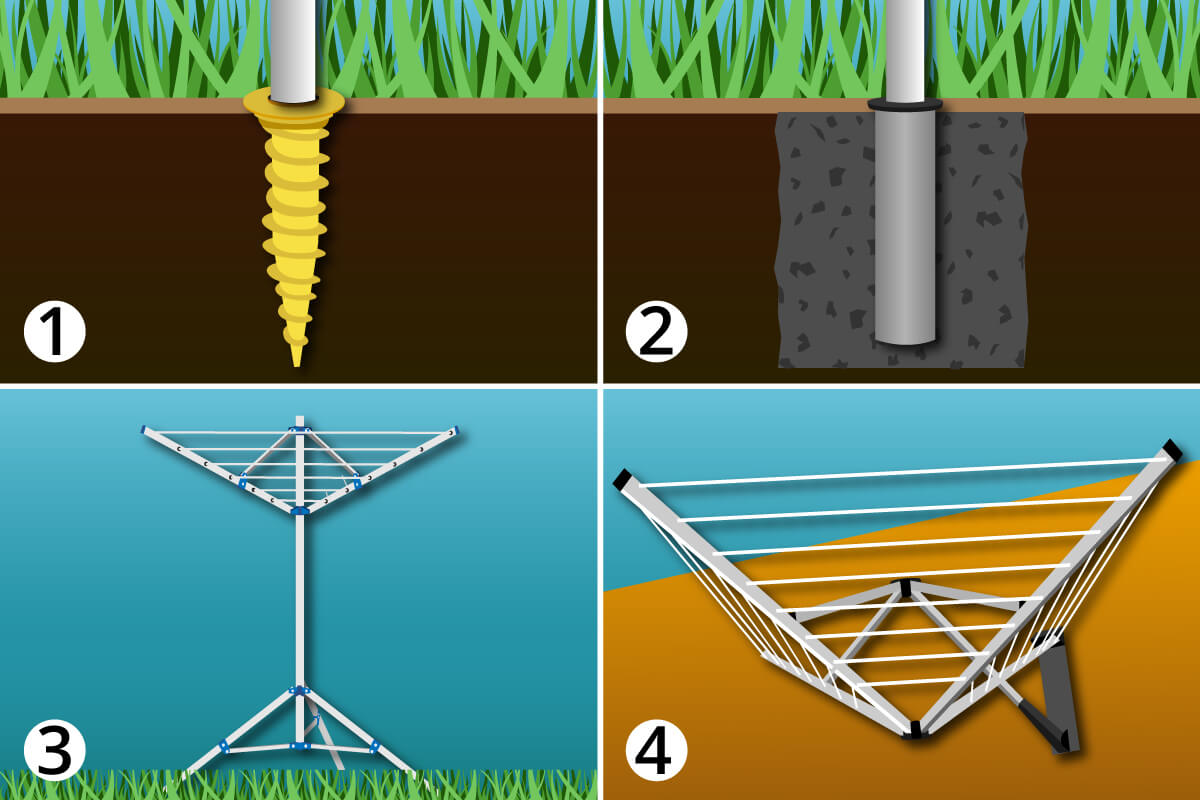
Ground anchor
You sink the anchor into the ground with a thread, in some cases with a spike. To do this, turn it into the ground with the help of a rod until it is just below the edge of the ground. The soil should be soft enough, so there should be no stones in the place. However, the soil should not be too soft so that the anchor does not sink into the ground. Once the dowel is in place, you can insert the central pole of the rotary dryer. Make sure that the tube corresponds to the size of the dowel. Some models come with adapters so that you can use the dowel for different model sizes. However, the dowel itself is not always included in the delivery. Check that the object is stable before hanging up laundry: The best way to simulate an upcoming wind is to move it slightly back and forth.
You can remove the rotary dryer from the peg at any time and use the lawn freely. Mowing the lawn is then also no problem. Make sure to cover the dowel when you remove the pole. Otherwise it could fill with water during rainy weather. Soil and turf could also get in and prevent the rotary dryer from sinking into it optimally. In this case, you will have to remove the foreign matter from the plug.
Advantages:
- Suitable for rental gardens
- Less work required
- Dowel is barely visible
Costs:
- 15 to 20 euros for the dowel
Dimensions:
- 50 to 65 millimetre dowel diameter
Ground socket
You sink the sleeve into the ground in exactly the same way as the dowel, but it requires a foundation. While the dowel has a thread and is screwed into the ground, the ground socket has a smooth edge. So first dig a hole with a diameter of about six by six centimetres and a depth equal to the length of the ground socket. Then fill the hole with concrete, making sure to leave a few centimetres to the edge of the lawn, as the sleeve will displace some concrete. When you have put the sleeve in, you can use a spirit level to check that it is straight.
Before you lower the rotary clothes dryer into the ground socket, you must wait until the concrete has dried. This can take a few days, but is necessary so that the rotary dryer is securely in the ground and does not tip over. If necessary, you can also detach the frame from the sleeve here to use the space or to store the rotary dryer underneath in bad weather. Make sure that the sleeve does not fill with water or soil. With this method, a piece of lawn space is lost, which is why the conversion is primarily recommended for people who have their own garden.
Advantages:
- More stable than ground pegs
- Can be removed from the sleeve
Costs:
- Around 10 euros for the dowel
- 10 to 20 euros for the concrete work
Dimensions:
- 30 to 55 millimetre sleeve diameter
- 35 to 45 centimetre concrete surface
Mobile rotary clothes dryer
Mobile rotary clothes dryers have a three-legged or two-legged stand that can also be folded up like a parasol. This makes them free-standing and location-independent. You can set them up anywhere, both indoors and outdoors, or use them during camping holidays. Keep in mind, however, that mobility comes at the expense of stability. Mobile rotary clothes dryers have 15 to 25 metres of line and are thus slightly smaller than ground-anchored versions so that they do not tip over due to excess weight. They are usually suitable for about two washing machine loads. Instead of being firmly anchored to the floor, mobile rotary clothes dryers only have an ordinary stand. Therefore, just like clothes horse stands, they are not tilt-proof, but are particularly susceptible to strong winds.
Advantages:
- Can be placed anywhere
Costs:
- 20 to 50 euros for the entire rotary clothes dryer
Dimensions:
- Foot diameter is about 50 centimetres
- Net diameter is about 100 centimetres
Wall-mounted rotary dryer
This rotary clothes dryer model is not anchored to the floor, but is attached to the wall. You unfold the laundry net by pulling the frame away from the wall. Wall-mounted rotary clothes dryers are slightly smaller than their standing counterparts, with a line length of around 25 metres. They are particularly suitable if you don’t have a garden, as they are easy to install on the patio or balcony. If you have enough space indoors, you can even install these rotary clothes dryers in the bathroom or basement. Pay attention to the declaration of the manufacturers, who sometimes refer to these variants as wall-mounted tumble dryers.
Advantages:
- Very space-saving
- Can be used on patios and balconies
Costs:
- 80 to 150 euros for the entire rotary clothes dryer
Dimensions:
- Wall bracket: 15 to 20 centimetres high
- Line net: about 100 centimetres in diameter
What is important when buying a rotary dryer?
When buying a rotary dryer, you should pay attention to the size or dimensions of the object. If you have a garden, you can also opt for larger models, while smaller versions are best used on a terrace or balcony, such as a wall-mounted rotary clothes dryer or a model with a stand.
The length of line you need depends on the amount of laundry you do. With a line retraction or extension, the clothesline remains protected even in wind and weather. A tensioning aid keeps the line taut, even if the soaked laundry is particularly heavy. Also pay attention to the materials used, as these ensure the stability of the spider.
Dimensions

Most rotary clothes dryers are between 1.50 and 2.50 metres high. When open, they have a diameter of 2.50 to 3.50 metres. They weigh between two and ten kilograms and can often carry up to 50 kilograms of laundry, depending on the size. Some rotary clothes dryers are height-adjustable so that you can adjust the net to a suitable height to prevent back pain.
Opening mechanism

You usually have to open the carrying frame by hand by pushing the central retaining ring upwards. On some models there is a pull rope in the middle of the bar. If you pull on this, you will move the rack upwards and avoid possible bruising of your fingers. Rotary clothes dryers with “Easy-Lift-System” are particularly easy to open with a handle on one of the support arms. Pull the handle and the net will open automatically by means of a gas spring.
Line length

In order to quantify how much space a rotary dryer offers, nowadays the built-in drying length of the line is always specified. This gives you an idea of how much space is effectively available to you. Common models usually have a line length of 10 to 60 metres. 50 to 60 metres are sufficient for about six loads of laundry, while 30 metres of line length can accommodate about two loads and 10 metres only one.
Line tightening

Even if the spider can withstand the load of laundry, the lines may loosen over time. If you do not have a model with automatic, you will have to tighten the line by hand. Since it is a continuous line, you have to tighten each piece individually. Line clamps can be used to ensure a tight line. A retightening aid automatically retightens the line as soon as it loosens.
Linen feed

On models with line retraction or extension, the lines are pulled into the support arms when you fold in the spider. This protects them when not in use. Without retraction, the lines would hang down loosely when folded, causing them to knot easily. You also need to clean the lines more regularly because they are exposed to the weather.
Materials

Rotary clothes dryers are made of weather and UV light resistant material such as aluminium or plastic, rarely steel. Aluminium or another sturdy metal is used for the frame, while the plastic used for the moving parts outside can become porous over time. Some manufacturers also use wood such as bamboo, pine and teak or make lines from hemp. Some rotary clothes dryers are not built entirely of wood, but only have a wooden sheathing. Purely wooden models cost around 1,000 euros.
Practical extras
With certain extras, you not only increase the effectiveness with which you dry your laundry, but also the lifespan of your rotary dryer.
Some models have a roof that stretches over the line net as soon as you open it. If your rotary dryer does not have a line retraction system, you can remedy this with a protective cover. Pull the protective cover over the folded-up rotary dryer to protect it from dirt and moisture. The lines also stay dry and clean. The only thing a protective cover will not protect you from is knotting of the lines. The end caps of some models, and in some cases the entire carrying arms, have hooks or eyelets for hanging delicate items of laundry on hangers to dry. Clothes pegs are always recommended when using a rotary dryer so that the laundry stays in place even in strong winds.
What size rotary dryer do I need?
Basically, you can assume that a ten-metre long clothesline will hold a washing machine load. This means that a small model is perfectly adequate for a single household. Households with two to three people are well advised to buy a rotary dryer with a clothesline of around 40 metres. These models cost between 50 and 75 euros. For households with four or more people, we recommend spiders with a line length of 50 to 60 metres, on which you can store up to six washing machine loads. You pay between 50 and 100 euros for this. Premium models with special functions, however, can cost up to 200 euros. If you run a household with five or more people, you should choose no less than 60 metres of line. If you mainly dry large items of laundry such as bed linen in a household, a rotary dryer with only three support arms is a good choice, as the individual pieces of line are correspondingly longer here.
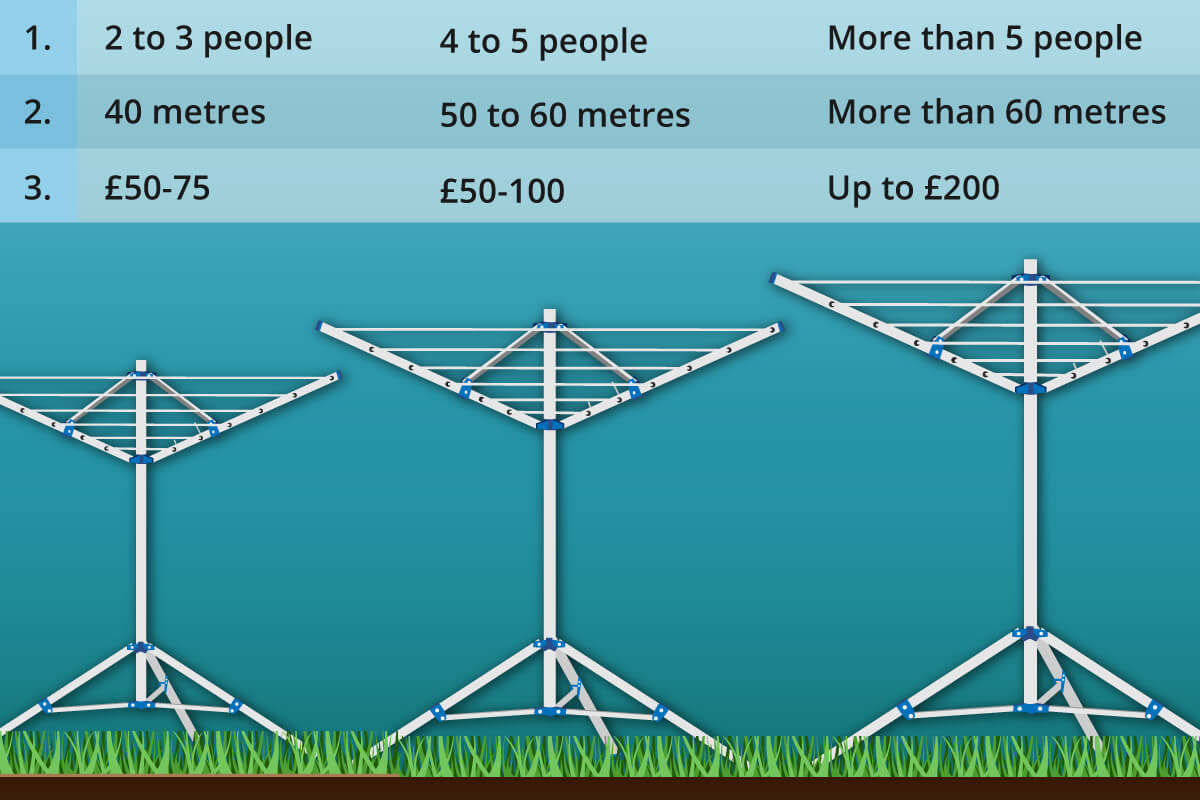
How stable is a rotary dryer?
Rotary dryers with a stand are the quickest to set up, but the most unstable. Rotary dryers that are embedded in a ground socket set in concrete offer the greatest stability. However, this work requires a lot of effort and is not possible on every property. The best compromise is a rotary dryer with a ground anchor. These can be easily turned or inserted into the ground and provide a secure hold. Although a dowel is not as firmly anchored as a sleeve, they are quick to insert and quick to remove, so you can change the location of your rotary dryer at any time.
Tips and tricks
The service life of your rotary dryer can be increased with just a few simple steps. The various models offer you an optimally distributed surface to hang up your clothes gently.
Where is the best place for a rotary dryer?
Even though some rotary dryers can be placed indoors, it is advisable to use them outdoors and place them in the garden, on the terrace or on the balcony. The choice of the right place is decisive for the drying result. Especially if you choose a ground socket set in concrete, you need to think carefully about the location. The sun is the best place to dry your laundry, but remember that too much sunlight can bleach the clothes. Do not place rotary dryers near trees or walls: The former usually cast too much shade, while the latter do not ensure sufficient air circulation. Make sure that the laundry does not dry near foreign smells: the rotary dryer should therefore not be located near a compost heap or kitchen window.
Clean, care, protect
You should clean the lines of your rotary dryer regularly, because dirt, pollen or other foreign matter can build up on them at any time of the year. To rid the lines of this, it is sufficient to wipe them occasionally with a damp cloth. For heavier soiling, you can add a little washing-up liquid. Although a line retractor ensures that the line is less susceptible to wind and weather when folded, you should still wipe it down regularly.
To prevent heavy soiling, do not leave the rotary dryer open, especially in rain and snow. Fold it up and pull a protective cover over the frame. Ideally, take the spider out of its holder and put it and the protective cover underneath in bad weather.
Drying laundry
Drying laundry outdoors has a number of advantages. Not only do you save space in your home, but you also save money and energy compared to machine drying. Clothes not only dry faster in the fresh air, they also retain a natural freshness. In addition, you do not need to use fabric softener when washing, as your clothes do not become stiff in the wind. Furthermore, you do not increase the humidity within your premises and thus prevent mould growth. However, keep in mind that sun rays can not only fade stains on clothes, but also affect the colour strength. If necessary, turn the clothes “inside out” so that they do not fade in the sun. Nevertheless, pay attention to where and how long you leave your laundry outside.
The outer line sections of a rotary dryer are best for large items of laundry such as bed linen or jumpers. Longer items, such as scarves, can also be hung up well here, as the outer lines are higher than the inner ones. This prevents your clothes from resting on the floor. You can use the inner lines for small items of clothing such as socks and underwear. Rotary clothes dryers are therefore designed for optimal distribution of the clothes.

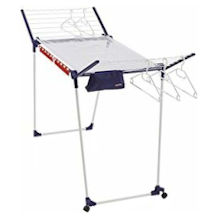
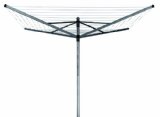
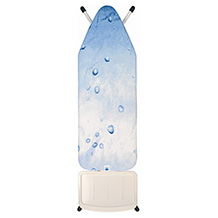

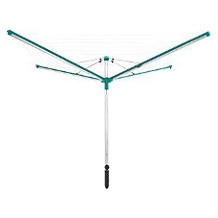
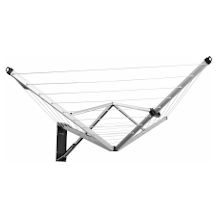
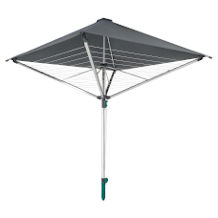
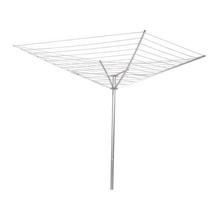
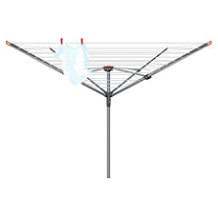
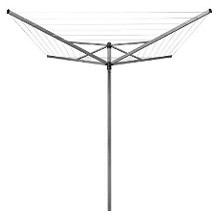

 965 reviews
965 reviews
